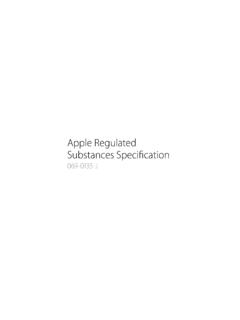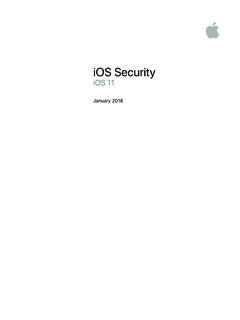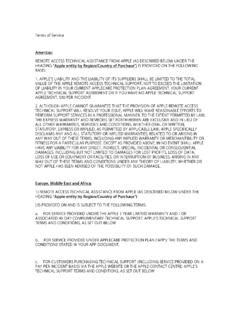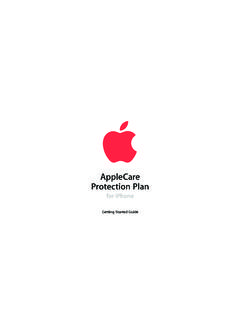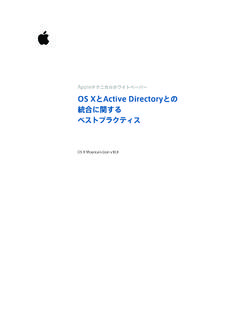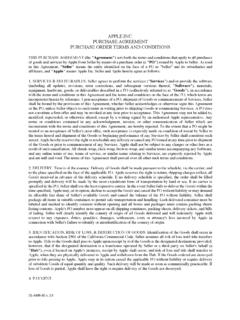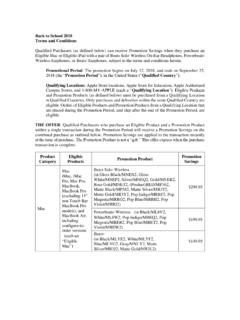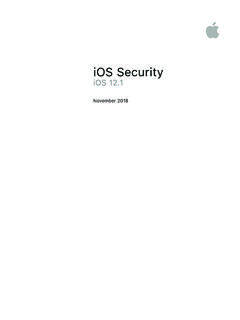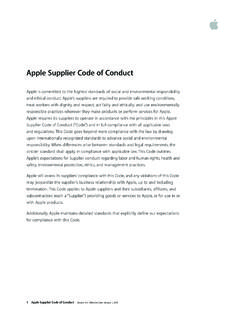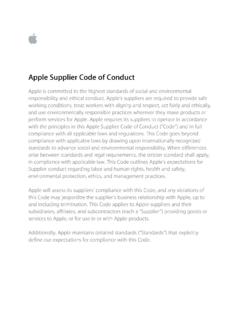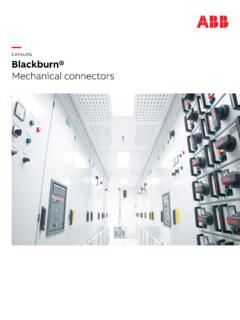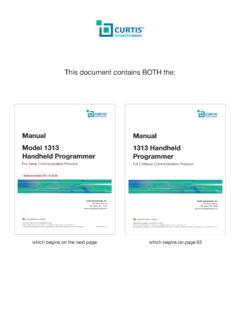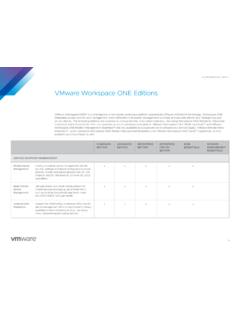Transcription of 069-0135-K SPEC, REGULATED SUBSTANCES Sept2018
1 apple REGULATED SUBSTANCES Specification 069-0135-K This document contains proprietary information of apple Inc. apple REGULATED SUBSTANCES Specification 069-0135-K | September 20181. Scope It s apple s mission to make sure that anyone who assembles, uses, or recycles an apple product can do so safely. We have led the industry in removing many harmful SUBSTANCES from our product designs, and we go to great lengths to make sure that they stay that way. We are constantly designing our products to be better for the environment, better for the people who use them, and better for the people who make them. This REGULATED SUBSTANCES Specification describes apple s global restrictions on the use of certain chemical SUBSTANCES or materials in apple s products, accessories, manufacturing processes, and packaging used for shipping products to apple s end-customers.
2 Restrictions are derived from international laws or directives, regulatory agency or eco-label requirements, and apple policies. apple s restrictions may go beyond regulatory requirements in order to protect human health and the environment. This specification is not an exhaustive list of all chemicals of concern. apple suppliers should take action to understand the human health and environmental impacts of all chemicals used in the manufacturing process and present in parts and materials supplied to apple . Suppliers should take action to reduce or eliminate the use of chemicals of concern listed in this specification as a first step, as well as comply with all applicable regulations.
3 Suppliers must certify compliance with this specification and provide required documentation (including required test data, Full Material Disclosure (FMD), and disclosure of reportable SUBSTANCES ). Suppliers must notify apple of any changes in formulation of materials or parts. We hold our suppliers accountable by conducting factory audits and testing materials and components at certified laboratories for SUBSTANCES of high concern. apple may verify supplier data and compliance to this specification utilizing our in-house laboratory. Effective Date: This specification takes effect on September 1, 2018. Prior to this date, revision J of the REGULATED SUBSTANCES Specification is in effect.
4 Questions: Questions regarding the apple REGULATED SUBSTANCES Specification should be directed to apple at 2 Scope | Definitions | Restricted SUBSTANCES in Products | Reportable SUBSTANCES and Future Restrictions in Products | Notifying apple of Chemical Phase Out and Reformulation from Suppliers | Restrictions in Manufacturing Processes Reportable SUBSTANCES and Future Restrictions in Manufacturing Processes | Supplementary Specifications | Demonstrating Compliance | Waiver Process | Full Material Disclosure (FMD) | Revision History | Referenced Documents | Appendices2. Definitions apple Policy: apple restrictions that go beyond regulatory requirements, based on best industry practices or toxicological properties.
5 CAS: Chemical Abstracts Service registry numbers that identify unique SUBSTANCES . Elemental chlorine free (ECF): Packaging material produced with pulp that has been bleached using a chlorine derivative such as chlorine dioxide (ClO2), but without the use of elemental chlorine (Cl). External Materials: Materials that are accessible to a customer under reasonable or foreseeable use. Final assembly: Manufacturing process involving assembly of a product that is then directly sold to apple customers, retail stores, or distribution channels. Endocrine Disrupting Chemicals (EDCs): Chemicals that can interfere with the endocrine (hormone) system to cause possible adverse effects in humans and wildlife.
6 Full Material Disclosure (FMD): Initiative that requires suppliers to provide the entire chemical composition of the parts and materials used in apple products to ensure compliance to regulatory requirements, corporate initiatives, and to support assessment of the impact to human and environmental health. See Section 11 for details. Homogeneous material: One material of uniform composition throughout or a material, consisting of a combination of materials, that cannot be disjointed, disaggregated, or separated into different materials by mechanical actions such as unscrewing, cutting, crushing, grinding, and abrasive processes. The definition is consistent with Directive 2011/65/EU on the Restriction of the Use of Certain Hazardous SUBSTANCES in Electrical and Electronic Equipment (RoHS 2).
7 Per this document, the following examples illustrate what is and is not a homogeneous material: A plastic cover is a homogeneous material if it consists of one type of plastic that is not coated with other materials, or has other materials attached to it. A cable that consists of metal wires surrounded by nonmetallic insulation materials isn t a homogeneous material because mechanical processes could separate the different materials. In this case, restrictions apply to each of the separated materials individually. A semiconductor package contains many homogeneous materials that include the mold compound, die attach adhesive, die coatings, bonding wires, lead frame, and lead frame platings.
8 Restrictions apply to each individual homogeneous material. Printed circuit board laminated materials consist of glass cloth, resins, and copper foil that are each a homogeneous material. Restrictions apply to each individual homogeneous material. Intentionally added: Substance deliberately used in the formulation of a material or component, where the presence of the substance in the final product provides a specific characteristic, appearance, or quality. Nanomaterials: A natural, incidental, or manufactured material containing particles, in an unbound state or as an aggregate or as an agglomerate and where, for 50 percent or more of the particles in the number size distribution, one or more external dimensions are in the size range 1 nm 100 nm.
9 In addition, fullerenes, graphene flakes, and single-wall carbon nanotubes with one or more external dimensions below 1 nm should be considered as nanomaterials. Non-use: Substance must not be intentionally or unintentionally added and is not detected using current or specified analytical methods. Packaging: Packaging materials used to enclose or protect apple products during shipment to the end-customer. Packaging shipped to suppliers or OEMs ( , tape and reel, trays), and packaging materials used to encapsulate board-level electrical components such as integrated circuits are not included in this definition. Per- and Polyfluoroalkyl SUBSTANCES (PFAS): SUBSTANCES that contain one or more perfluoroalkyl moieties, CnF2n+1.
10 Personal protective equipment (PPE): Equipment for protecting workers from exposure to hazardous materials in the workplace specific to the job function. ppm: Parts per million by weight of a substance; equivalent to 1 mg/kg or percent by weight. Processed chlorine free (PCF): Packaging material produced with pulp from virgin and/or recycled content that has been bleached without any type of chlorine, or that has not been bleached at all. Recycled content may have originally been bleached with chlorine or chlorine derivatives. Test Report Mapping (TRM): The form used to map test reports to declared materials. The TRM form is created in and exported from the FMD Portal and replaces the Material Content Declaration (MCD) form.
